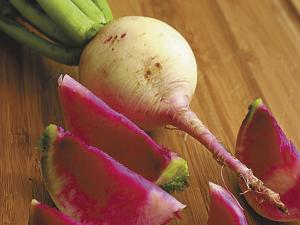Winter radishes come in many delicious varieties
Spring can be such a mixed blessing. We rush to get out early into the garden only to find that true, the early bird gets the worm, but sometimes the early worm gets eaten.
Spring rains, spring mud and spring snow can give a gardener a headache. Luckily, an old-fashioned headache remedy is one of the quickest, easiest crops to grow.
While it is still too cool to plant warm-season vegetables outside such as squash, tomatoes, eggplant, peppers or corn, you can plant radishes (Raphanus sativus.)
In addition to the familiar round, red spring radishes, there are the larger, slower- growing winter radishes such as Daikon and Black Spanish. So-called Watermelon radishes are green with neon pink flesh. These are much sweeter than their smaller cousins, and when sliced make colorful additions to salads or appetizer trays. Many people eat them raw with a touch of sea salt.
The imposing Black Spanish radishes are inky black with a bumpy skin surrounding brilliant white flesh.
Try cooking them like turnips and beets, which mellows their flavor. Many gardeners are familiar with the large, carrot-shaped Daikon radishes with thick, long, white roots. These are so tasty that some people even juice them.
Germany gives us the Muncher Bier radish. These beer radishes are traditionally served raw or pickled along with steins of frothy beer. Muncher Bier radishes have crisp white flesh and are said to aid digestion.
Jesuit missionaries gave us the light pink China Rose radish in the 1850s. Long, carrot-shaped eight-inch radishes have smooth skins in a beautiful mauve pink. Like many winter radishes, this one is a good keeper.
Seeds for winter radishes are widely available at local nurseries and garden shops or online from vendors such as Johnny’s Seeds (www.Johnnyseeds.com) or Seed Savers Exchange (www.Seedsavers.org).
Plant radishes as soon as your soil can be worked. Pick a spot with full sun in light, well-drained soil.
Radishes prefer a neutral soil, so try for a soil pH of 5.8 to 6.8 for best yields. Like any root crop they do best if you dig the soil down and break up any clumps. Try to remove stones and debris.
Sow the tiny round seeds a few inches apart. Cover the seeds with just a half inch of soil and tamp down to prevent air pockets.
Because radishes are so easy to grow, many gardeners use them as row markers and sow radish seeds alongside slower- germinating crops. That way, the new radish plants show you where the row is, and keep you from weeding or hoeing the slower-growing vegetables.
Like many crops, too much nitrogen will result in lots of leaves and few radishes. Once your radishes are up and growing, thin the plants to stand at least three inches apart.
Keep the radishes well watered but not soggy. A light mulch can help keep in soil moisture and keep out weeds.
Hot, dry weather may cause your radishes to bolt, or go to seed. When this happens all of the plant’s energy goes into sending up flower spikes and the radish roots will be dry, hard and pithy.
Radishes serve another role in the garden by acting as a catch crop or trap crop. Radishes can often attract pests such as aphids, flea beetles, and other insects away from other crops.
To harvest your radishes pull them up roots and all. If you cut the leaves off immediately, they will actually last longer because the dead leaves often draw moisture up from the radish roots. Radishes will store in the refrigerator for up to a week.
You can let some radishes bolt, or go to seed. Use the seedpods in stir fries or steamed. Some folks even eat them raw in salads. Like most root vegetables, radishes can be pan fried with spices and butter for an unusual side dish.
You can grate them into salads. Chop some into potato salad. Try pickling the larger winter radishes.
So get out and plant radishes. They’re quick; they’re easy; they even are said to relieve headaches. And a garden without a headache can be its own reward.





















































